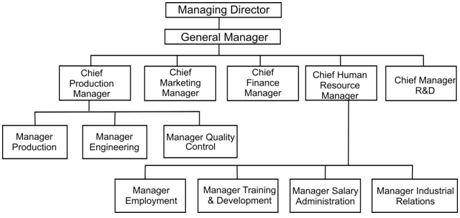Functional Organisation Structure:
In this structure every functional department consists of those jobs in that employees perform similar jobs at various levels. The generally used functions are: marketing, finance and accounting, manufacturing, research and development, human resources, & engineering.

Figure: Functional Organisation Structure
Table: Advantages and Disadvantages of a Functional Organisation Structure
|
Advantages
|
1. In-depth specialisation and focussed concentration on performing functional tasks can enhance operating efficiency and development of core competencies.
2. This structure promotes maximum utilisation of up-to-date technical skills and enables the firm to capitalise on specialisation and efficiency.
3. This structure promotes common values and goals among employees of the department, facilitating cooperation & collaboration along with the functional department.
4. Enhances operating efficiency where tasks are routine and repetitive.
|
|
Disadvantages
|
1. The department members will see the activities from the view point of the department rather than the total organisation. These outputs in the absence of inter-departmental coordination and cooperation.
2. The narrow specialisation kills the initiative of entrepreneurs and the zeal of innovativeness and creativeness.
3. This kind of structure promotes over specialization and narrow management viewpoints.
4. This kind of structure is effective only in stable environment.
5. This also results in absence of accountability.
|